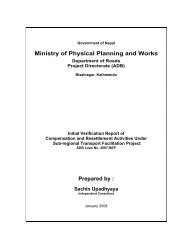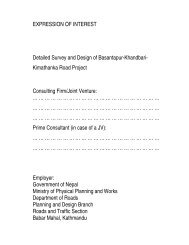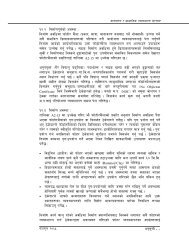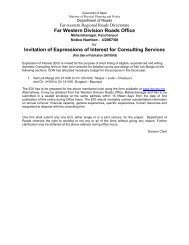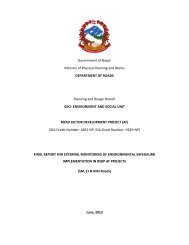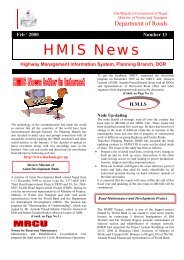Environmental & Social Management Framework - About ...
Environmental & Social Management Framework - About ...
Environmental & Social Management Framework - About ...
Create successful ePaper yourself
Turn your PDF publications into a flip-book with our unique Google optimized e-Paper software.
<strong>Environmental</strong> and <strong>Social</strong> <strong>Management</strong> <strong>Framework</strong>(9) EIA-Report Preparation and ApprovalThe borrower's decision to proceed with a project, and the Bank’s decision tosupport it, is predicated in part on the expectation that the EMAP will be executedeffectively. Consequently, the World Bank expects the EMAP to be site specificand detailed in its description of the individual mitigation and monitoringmeasures and its assignment of institutional responsibilities, and it must beintegrated into the project's overall planning, design, budget, and implementation.The following table summarizes the content of an EIA Report, tailored for theproposed SRN sub-project and in accord with the prescribed in Schedule 5related to Rule 7 of the EPR:Table 2.11: Table of Content of an EIA Report pertaining to SRN subprojectsStandard Format Required for EIA Reports1. Name and address of individual or institution preparing the report (proponent)2. Executive Summary, in Nepali and English, indicating• Name and location of the proposed project• Brief description of the project• List of development permits or public financial assistance• Summary of identified alternatives• Summary of potential environmental impacts• - List of key mitigation measures3. Detailed Description of the Project• Type, size, and proposed use of project• Objective and anticipated benefits of the project• Description of physical characteristics of the project and its surrounding, illustration withlocation map and site plan in appropriate scale and level of details• A time table, approximate cost, and methods and timing of construction of the project.• Other necessary matters4. Existing <strong>Environmental</strong> Condition – Description and analysis of physical, biological,chemical, economic, and social condition of the project site, surroundings and theregion.• Physical Environment – topography, geology, seismicity, hydrology (surface andground water), climate, air quality, and noise,• Biological Environment - Plants, animals and habitats, national parks, sanctuary, rareand endangered species, sensitive ecological areas• Socio-economic and cultural- Population, settlement, community Infrastructures (Irrigation, drinking water, schools, etc), Agricultural land, Potential for development (cash crop, industry, etc), recreational resources, scenic qualities, open spaces,historical, cultural and religious sites,5. Impact Identification, prediction and Evaluation – Analysis of positive, negative,direct, indirect, extent, duration, reversibility and magnitude. The impact should beidentified in relation to the construction, and operation stages• Physical• Biological• Socio-economic and Cultural6. Alternatives of Project• Project Alternative• Alternative Route• Alternative Design and Construction Methods• Do Nothing AlternativeChapter 2-32 April 2007



![j:6 ]zg cfof ]hgf](https://img.yumpu.com/51286794/1/190x245/j6-zg-cfof-hgf.jpg?quality=85)

![x'nfsL /fhdfu { cfof ]hgf](https://img.yumpu.com/50581959/1/190x245/xnfsl-fhdfu-cfof-hgf.jpg?quality=85)
